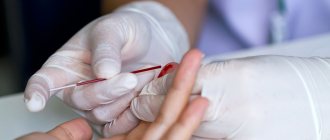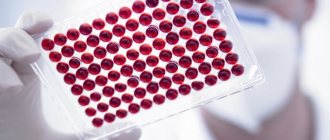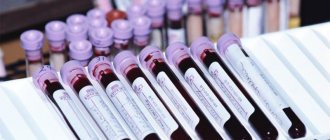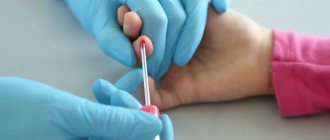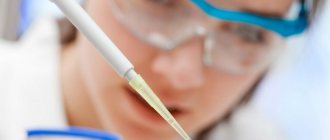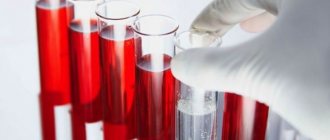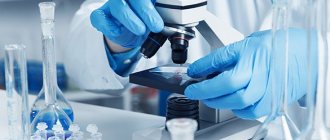Synonyms: determination of total IgE, immunoglobulin E, immunoglobulin E total, immunoglobulin class E, IgE, IgG total, Immunoglobulin E.
Related tests: allergy screening: inhalation, food, inhalation-food, pediatric panels, complete blood count.
Determination of total IgE is carried out to identify allergies. This indicator is also used as an additional method for differentiating atopic diseases with an allergic component among a variety of pathologies clinically manifested as asthma, frequent respiratory diseases, chronic rhinitis, dermatitis, chronic diarrhea and others.
Immunoglobulin E (Ig E) general - diagnosis of allergic conditions
Material for research: blood serum.
Research method: IECHL.
Execution time: 1 working day.
Blood collection for general Immunoglobulin E (Ig E) is performed at all BRIGHT-Bio points.
Determination of the content of total Ig E in blood serum is used to diagnose atopic allergic diseases.
Preparation for the study: blood is taken on an empty stomach. At least 8 hours (preferably 12 hours) must pass between the last meal and the test. Juice, tea, coffee (especially with sugar) are not allowed. You can drink water.
The half-life of immunoglobulin class E ( Ig E) is 3 days in blood serum, and 14 days on the membranes of mast cells and basophils. The mechanism of atopic allergic reactions is closely related to immunoglobulins E. They have the ability to quickly fix on skin cells, mucous membranes, mast cells and basophils, therefore free Ig E is present in the blood plasma in small quantities. In addition to participating in type 1 allergic reactions , Ig E also takes part in protective anthelminthic immunity, which is due to the existence of cross-linking between Ig E and the helminth antigen.
Elevated Ig E in children with allergies and hypersensitivity to a large number of allergens are detected more often than in children with hypersensitivity to a small number of allergens, as well as in children whose target organs are not involved in the allergic process. Ig E levels in sick children with hypersensitivity to food and pollen allergens is higher than in children with hypersensitivity to house dust and mold.
In adults, determining the level of Ig E has less diagnostic value than in children. Elevated levels of Ig E are detected only in 60% of patients suffering from atopic bronchial asthma. The highest values of Ig E in the blood are observed with hypersensitivity to a large number of allergens in combination with asthma, dermatitis and rhinitis. With hypersensitivity to one allergen, the level of total Ig E may be within normal limits.
Allergic bronchopulmonary aspergillosis is accompanied by a significant increase in the level of Ig E in the blood. Its concentration is increased in almost every patient with allergic aspergillosis during the period of pulmonary infiltration.
Ig E level in patients with active lung disease excludes the diagnosis of aspergillosis.
When assessing the results of determining total Ig E , it should be borne in mind that in approximately 30% of patients with atopic diseases, the level of this immunoglobulin may be within normal limits.
When diagnosing an allergy, it is not enough to note an increase in total Ig E in the blood. Ig E antibodies against it.
Since the beginning of 2011, the BRIGHT-Bio laboratory has been determining allergen-specific Ig E in blood serum to various allergens grouped in panels.
- Allergy panel Polycheck Pediatric No1 (APPd1)
BRIGHT-Bio is making efforts to expand the list of Allergy panels.
The detection of allergen-specific Ig E (to any allergen or antigen) does not yet prove that this particular allergen is responsible for the clinical symptoms. The final conclusion and interpretation of the results should be made only after comparison with the clinical picture and allergy history data. The absence of specific Ig E in the blood serum does not exclude the possibility of participation in the pathogenesis of the disease Ig E -dependent mechanism, since local synthesis of Ig E and sensitization of mast cells can occur in the absence of specific Ig E in the bloodstream (for example, with allergic rhinitis).
Preparation
The IgE immunoglobulin test is carried out strictly on an empty stomach. For the study, nurses at the Yusupov Hospital collect venous blood, observing the rules of asepsis and antiseptics. Before the test, it is not recommended to eat food for 10-12 hours, and fatty foods and alcohol should be excluded from the diet one day before the test. You can drink clean still water.
During the several days preceding the study, patients are not given an ultrasound examination, IVs are not placed, and X-rays are not taken. They are not recommended to visit the solarium, sauna or sunbathing. 2-3 days before the study you need to stop playing sports and fitness. The IgE immunoglobulin test is carried out within 3 days. The results of the study in complex cases are discussed at a meeting of the expert council. Doctors at the Yusupov Hospital make a collective decision on further treatment tactics for the patient.
Norm and changes in indicators
The normal concentration of immunoglobulin IgE in newborns is considered to be up to 1.5 IU/ml, in children 1-5 years old - up to 60.0 IU/ml, 6-9 years old - up to 90.0 IU/ml, 10-15 years old - up to 200 .0 IU/ml. Normally, the level of immunoglobulin IgE does not exceed 100.0 IU/ml. Total immunoglobulin e IgE may be high in patients receiving penicillin antibacterial drugs, but decreased when taking phenytoin.
An increase in the level of immunoglobulin IgE is observed in patients suffering from atopic allergic diseases (allergic rhinitis, atopic bronchial asthma, atopic dermatitis, allergic gastroenteropathy). Immunoglobulin IgE may be high in patients with the following diseases:
- anaphylactic reactions (systemic anaphylaxis, angioedema);
- allergic bronchopulmonary aspergillosis;
- helminthiasis;
- hyper-IgE syndrome (Job syndrome);
- Wiskott-Aldrich syndrome;
- selective IGA deficiency;
- thymic aplasia (DiGeorge syndrome);
- IgE myeloma.
The concentration of immunoglobulin Ig e increases in the case of graft-versus-host disease. A decrease in the level of immunoglobulin IgE may indicate a significant deterioration in the function of the immune system, the presence of immunodeficiency or myeloma.
Make an appointment with an immunologist at the Yusupov Hospital by calling. The doctor will conduct an examination and prescribe an IgE immunoglobulin test. After discussing the results of the study, treatment will be prescribed.
Indications
Only a specialist (immunologist, allergist, general practitioner, pediatrician, etc.) can interpret the results. When diagnosing, the general clinical picture of the disease, features of the allergy history, etc. are important.
- Assessment of the risk of developing allergies in children (in this case, the concentration of immunoglobulin is considered as a prognostic indicator);
- Study and assessment of the state of the immune system as a whole;
- Diagnosis of helminthic infestations;
- Differential diagnosis of all allergic reactions with similar symptoms;
- Selection of treatment tactics for pulmonary aspergillosis (pathology caused by a moldy fungus of the genus Aspergillus);
- Monitoring the effectiveness of treatment of allergic diseases and symptom complexes;
- Diagnosis of certain conditions associated with immunodeficiency;
- Determination of the type and degree of sensitization to a specific allergen.
Bibliography
- Arnold JN, Wormald MR, Sim RB, et al. The impact of glycosylation on the biological function and structure of human immunoglobulins // Annu Rev Immunol 2007; 25:21.
- Balzar S, Strand M, Rhodes D, Wenzel SE. IgE expression pattern in lung: relation to systemic IgE and asthma phenotypes // J Allergy Clin Immunol 2007; 119:855.
- Bellou A, Kanny G, Fremont S, Moneret-Vautrin DA. Transfer of atopy following bone marrow transplantation // Ann Allergy Asthma Immunol 1997; 78:513.
- Bernstein IL, Li JT, Bernstein DI, et al. Allergy diagnostic testing: an updated practice parameter // Ann Allergy Asthma Immunol 2008; 100:S1.
- Cameron L, Gounni AS, Frenkiel S, et al. S epsilon S mu and S epsilon S gamma switch circles in human nasal mucosa following ex vivo allergen challenge: evidence for direct as well as sequential class switch recombination // J Immunol 2003; 171:3816.
- Coker HA, Durham SR, Gould HJ. Local somatic hypermutation and class switch recombination in the nasal mucosa of allergic rhinitis patients // J Immunol 2003; 171:5602.
- Cooper AM, Hobson PS, Jutton MR, et al. Soluble CD23 controls IgE synthesis and homeostasis in human B cells // J Immunol 2012; 188:3199.
- Dullaers M, De Bruyne R, Ramadani F, et al. The who, where, and when of IgE in allergic airway disease // J Allergy Clin Immunol 2012; 129:635.
- Eckl-Dorna J, Pree I, Reisinger J, et al. The majority of allergen-specific IgE in the blood of allergic patients does not originate from blood-derived B cells or plasma cells // Clin Exp Allergy 2012; 42:1347.
- Egger C, Horak F, Vrtala S, et al. Nasal application of rBet v 1 or non-IgE-reactive T-cell epitope-containing rBet v 1 fragments has different effects on systemic allergen-specific antibody responses // J Allergy Clin Immunol 2010; 126:1312.
- Fregonese L, Patel A, van Schadewijk A, et al. Expression of the high-affinity IgE receptor (FcepsilonRI) is increased in fatal asthma // Am J Respir Crit Care 2004; 169:A297.
- Geha RS, Jabara HH, Brodeur SR. The regulation of immunoglobulin E class-switch recombination // Nat Rev Immunol 2003; 3:721.
- Gergen PJ, Arbes SJ Jr, Calatroni A, et al. Total IgE levels and asthma prevalence in the US population: results from the National Health and Nutrition Examination Survey 2005-2006 // J Allergy Clin Immunol 2009; 124:447.
- Granada M, Wilk JB, Tuzova M, et al. A genome-wide association study of plasma total IgE concentrations in the Framingham Heart Study // J Allergy Clin Immunol 2012; 129:840.
- Hamilton RG, Franklin Adkinson N Jr. In vitro assays for the diagnosis of IgE-mediated disorders // J Allergy Clin Immunol 2004; 114:213.
- Hamilton RG, Williams PB, Specific IgE Testing Task Force of the American Academy of Allergy, Asthma & Immunology, American College of Allergy, Asthma and Immunology. Human IgE antibody serology: a primer for the practicing North American allergist/immunologist // J Allergy Clin Immunol 2010; 126:33.
- Hamilton RG. Accuracy of US Food and Drug Administration-cleared IgE antibody assays in the presence of anti-IgE (omalizumab) // J Allergy Clin Immunol 2006; 117:759.
- Hibbert RG, Teriete P, Grundy GJ, et al. The structure of human CD23 and its interactions with IgE and CD21 // J Exp Med 2005; 202:751.
- Holgate S, Casale T, Wenzel S, et al. The anti-inflammatory effects of omalizumab confirm the central role of IgE in allergic inflammation // J Allergy Clin Immunol 2005; 115:459.
- Kamemura N, Tada H, Shimojo N, et al. Intrauterine sensitization of allergen-specific IgE analyzed by a highly sensitive new allergen microarray // J Allergy Clin Immunol 2012; 130:113.
- Lynch NR, Hagel IA, Palenque ME, et al. Relationship between helminthic infection and IgE response in atopic and nonatopic children in a tropical environment // J Allergy Clin Immunol 1998; 101:217.
- Martins TB, Bandhauer ME, Bunker AM, et al. New childhood and adult reference intervals for total IgE // J Allergy Clin Immunol 2014; 133:589.
- McSharry C, Xia Y, Holland CV, Kennedy MW. Natural immunity to Ascaris lumbricoides associated with immunoglobulin E antibody to ABA-1 allergen and inflammation indicators in children // Infect Immun 1999; 67:484.
- Moffatt MF, Gut IG, Demenais F, et al. A large-scale, consortium-based genomewide association study of asthma // N Engl J Med 2010; 363:1211.
- Niederberger V, Ring J, Rakoski J, et al. Antigens drive memory IgE responses in human allergy via the nasal mucosa // Int Arch Allergy Immunol 2007; 142:133.
- Oettgen HC, Geha RS. IgE regulation and roles in asthma pathogenesis // J Allergy Clin Immunol 2001; 107:429.
- Pien GC, Orange JS. Evaluation and clinical interpretation of hypergammaglobulinemia E: differentiating atopy from immunodeficiency // Ann Allergy Asthma Immunol 2008; 100:392.
- Poole JA, Meng J, Reff M, et al. Anti-CD23 monoclonal antibody, lumiliximab, inhibited allergen-induced responses in antigen-presenting cells and T cells from atopic subjects // J Allergy Clin Immunol 2005; 116:780.
- Schroeder HW Jr, Cavacini L. Structure and function of immunoglobulins // J Allergy Clin Immunol 2010; 125:S41.
- Selb R, Eckl-Dorna J, Twaroch TE, et al. Critical and direct involvement of the CD23 stalk region in IgE binding // J Allergy Clin Immunol 2017; 139:281.
- Shade KT, Platzer B, Washburn N, et al. A single glycan on IgE is indispensable for initiation of anaphylaxis // J Exp Med 2015; 212:457.
- Stone KD, Prussin C, Metcalfe DD. IgE, mast cells, basophils, and eosinophils // J Allergy Clin Immunol 2010; 125:S73.
- Takhar P, Corrigan CJ, Smurthwaite L, et al. Class switch recombination to IgE in the bronchial mucosa of atopic and nonatopic patients with asthma // J Allergy Clin Immunol 2007; 119:213.
- Takhar P, Smurthwaite L, Coker HA, et al. Allergen drives class switching to IgE in the nasal mucosa in allergic rhinitis // J Immunol 2005; 174:5024.
- Thorpe SJ, Heath A, Fox B, et al. The 3rd International Standard for serum IgE: international collaborative study to evaluate a candidate preparation // Clin Chem Lab Med 2014; 52:1283.
- Tsicopoulos A, Joseph M. The role of CD23 in allergic disease // Clin Exp Allergy 2000; 30:602.
- Vercelli D. Genetic regulation of IgE responses: Achilles and the tortoise // J Allergy Clin Immunol 2005; 116:60.
- Walker SA, Riches PG, Wild G, et al. Total and allergen-specific IgE in relation to allergic response pattern following bone marrow transplantation // Clin Exp Immunol 1986; 66:633.
- Watanabe N, Katakura K, Kobayashi A, et al. Protective immunity and eosinophilia in IgE-deficient SJA/9 mice infected with Nippostrongylus brasiliensis and Trichinella spiralis // Proc Natl Acad Sci USA 1988; 85:4460.
- Weidinger S, Gieger C, Rodriguez E, et al. Genome-wide scan on total serum IgE levels identifies FCER1A as novel susceptibility locus // PLoS Genet 2008; 4:e1000166.
